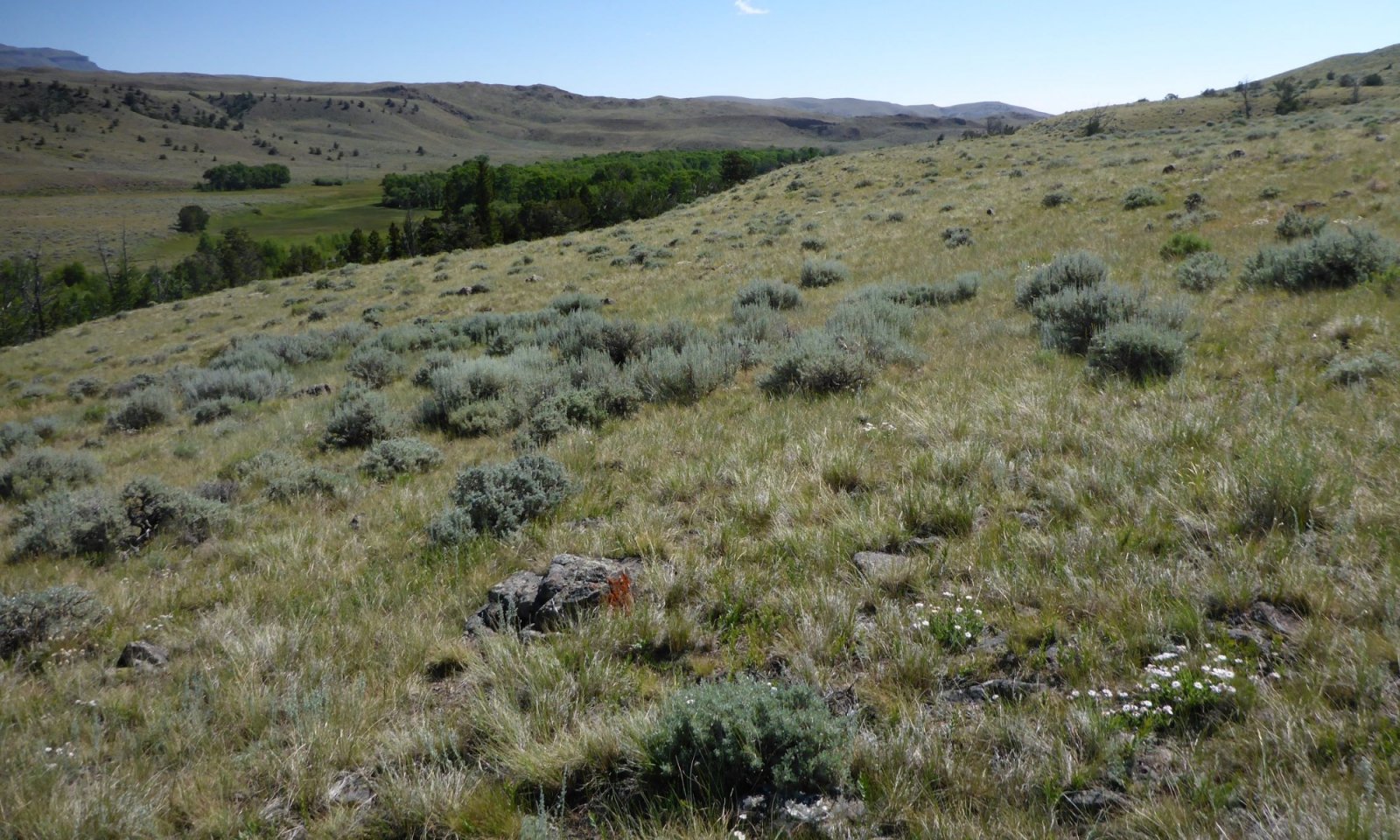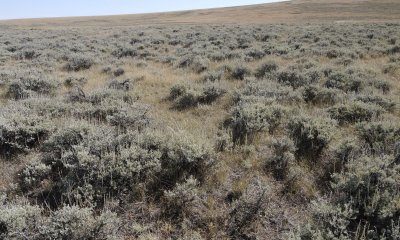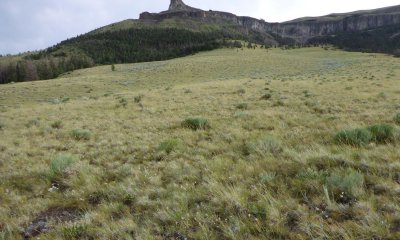
Loamy Calcareous (LyCa) Absaroka Upper Foothills
Scenario model
Current ecosystem state
Select a state
Management practices/drivers
Select a transition or restoration pathway
-
Transition T1-2
Frequent and severe grazing with the change in fire frequency, drought, and other significant impacts to the herbaceous cover force this transition.
More details -
Transition T1-3
Fire, drought, and other major disturbances with a seed source present aid in this transition.
More details -
Transition T2-3
Continued frequent and severe use patterns, significant soil disturbance, drought, and other catastrophic events with a seed source present will transition this site to the Invaded State.
More details -
Restoration pathway R3-4
An integrated weed management plan with a native seeding and long-term prescribed grazing aids the transition of this site.
More details -
Transition T4-3
Lack of management, continued disturbance, failure of a reclamation process, or catastrophic events with seed source present will transition this community to the invaded state.
More details -
No transition or restoration pathway between the selected states has been described
Target ecosystem state
Select a state
State 1
Bluebunch Wheatgrass/Needlegrass/Sagebrush



Description
State 1 is named the Bluebunch Wheatgrass/Needlegrass/Sagebrush State, in response to the dominance of mid to tall-stature cool-season bunchgrasses that are prominent in each community. Rhizomatous wheatgrasses and mid to short-stature cool-season bunchgrasses are secondary in these communities. Sagebrush is present, but is not the major cover class.
Characteristics and indicators
Bluebunch Wheatgrass/Needlegrass/Sagebrush State (State 1 - Reference) is characterized by the key species including: 15 percent or less composition by cover of mountain big sagebrush and black sagebrush, with bluebunch wheatgrass (less than 30 percent), rhizomatous wheatgrasses, and various other bunchgrasses.
The modal concept for this site is in the fine-loamy (greater than 18 percent clays), however there are a few areas where the textures are coarser than this with similar plant characteristics (minor shifts). To cover this variance, the range of plant composition will capture this characteristic within the plant community tables.
Resilience management
This State is stable, even with moderate, continuous season-long grazing. The communities are tolerant of drought. But after time and extensive pressure or disturbance this community will begin to shift to a fescue driven community.
Submodel
Description
After significant pressure on the herbaceous understory and with the lack of fire to rejuvenate the woody component, this State has shifted to a mid and short-stature cool-season grasses with shrubs becoming a significant component of this state. Some of the preferred grasses have been reduced or are absent, and forbs (ground covering) have increased in the community.
When compared to the Reference State, sagebrush, Idaho fescue, native bluegrasses, prairie junegrass, and rhizomatous wheatgrasses have increased. Most of the preferred grasses have been reduced and some are absent.
Characteristics and indicators
Dominant grasses include Idaho fescue, spike fescue, bluebunch wheatgrass, and rhizomatous wheatgrasses. Grasses of secondary importance include slender wheatgrass, spike trisetum, prairie junegrass, and bluegrasses. Columbia needlegrass, spike fescue, and bluebunch wheatgrass are significantly reduced or absent.
Forbs commonly found in this plant community include lupine, phlox, agoseris, pussytoes, Indian paintbrush, and asters. Fringed sagewort, mountain big sagebrush, and juniper can make up to 25% of the total annual production. Black sagebrush and rubber rabbitbrush are common in the community.
Resilience management
This State is resistant to change without a major disturbance or inputs to start the change. But it is also at risk of degrading further and is susceptible to invasion due to the decreased herbaceous cover and increased woody structure.
Submodel
Description
This plant community evolved under frequent and severe heavy grazing and the mountain big sagebrush shrub component has been reduced or possibly removed by heavy browsing, wildfire or human means. Non-native and weedy species are the most dominant plants and occupy any open bare ground area. Fringed sagewort and rubber rabbitbrush may or may not be present. However, it is common for these shrubs to occur as both are strong resprouters and may quickly re-establish the site after a disturbance.
Characteristics and indicators
The major indication of entering this State is the abundant or significant presence of an introduced species, whether invasive or just an invader. To meet the terms of abundant or significant, the presence has to account for greater than or equal to ten percent cover of the community.
Compared to Reference, non-native invaders such as smooth brome, timothy and kentucky bluegrass as well as weedy annual species are widespread and the major cool-season mid-grasses are absent or severely decreased. Mountain big sagebrush has also been impacted. Weedy annuals may include cheatgrass, Canada thistle, Russian thistle, and a variety of mustards. The interspaces between plants have expanded leaving the amount of bare ground more prevalent and more soil surface exposed to erosive elements.
Resilience management
This plant community is relatively stable and resistant to overgrazing. Annuals and non-native species are effectively competing against the establishment of native perennial cool-season grasses. Plant diversity is greatly altered and the herbaceous component is not intact. Recruitment of the major perennial grasses is not occurring and the replacement potential is absent. The biotic integrity is missing.
The soils are unstable and not protected from excessive erosion. Rill channels and maybe even gullies may be present on site and adjacent areas are impacted by excessive runoff. Water flow patterns and pedestalling are obvious. The watershed is not functioning.
Submodel
Description
Catastrophic natural events, including fresh land slides, fire followed by extreme climatic events, or areas that are heavily impacted by recreational vehicles, trails, roadways, or other land disturbances have reduced or removed most native perennial vegetation and left a highly disturbed land. These points of disturbance can be large scale, encompassing several ecological sites. However, many times they are isolated in nature, especially on steeper slopes.
The Disturbed State could be drafted as a stand-alone box within the state and transition model diagram. No matter what state a site originally is ranked in, once the site is mechanically disturbed, or suffers a catastrophic or significant natural disaster that alters the soil properties (erosional, depositional, hydrologic, or chemical), the site potential is altered.
Mechanical disturbances and reclamation practices using non-native species could qualify some stages of this state to be considered as a land use shift. The result is the shift in potential and response in management so that it is no longer similar to the reference community. The potential shifts are highly variable, so a dynamic state was captured to highlight the altered communities that exist on the landscape.
Characteristics and indicators
The soil disturbance and mechanical or physical removal of the vegetative canopy is the key characteristic of the Disturbed State. The initial indicators are the primary successional species that establish following a disturbance including Russian thistle, kochia, six weeks fescue, and sunflowers. These initial colonizers will then be followed by any seeded species, or other species from within the locations seed bank.
Resilience management
The Disturbed State is highly variable and in a state of flux as the successional processes occur. Continued disturbance of this community is a potential threat; and the community is at high risk of transitioning to the Invaded State.
Submodel
Mechanism
Heavy, continuous, season-long grazing plus no fires or altered fire frequency will convert the plant community to the Sagebrush/Idaho Fescue State. This is especially evident on areas where drought or heavy browsing has adversely impact the shrub stand. The impacts required to force this transition are significant, and this does not happen in a short time period.
Constraints to recovery
The loss of sagebrush in some of these communities and the lack of necessary seed bank and recovery time are limiting factors for this State to recover. Slope and erosional risks are also slows or inhibits recovery.
Mechanism
Fire, wild or prescribed, with no change in grazing management and seed source present allows for a rapid transition to the Invaded State. Drought or other catastrophic events will aid in this transition.
Constraints to recovery
The lack of effective treatment to eradicate or significantly control invasive species long term or to remove non-native species without impact to the native community limit the recovery of this State.
Mechanism
Drought, soil disturbances, or high-intensity grazing with a seed source present can open the soil surface and weaken the sod allowing non-native and invasive species to establish. Fire is a primary means of provide the niche for cheatgrass to establish on this site. Continued stress on a community, even and aggressive non-native dominant community is prone to drought and grazing pressure allowing invasive species to establish.
Constraints to recovery
The nature of non-native (introduced) as well as invasive species, especially cheatgrass, once they are established, they are prolific reproducers and are hardy plants, making it costly and difficult (if even possible) to remove. The lack of key grass species also limits recovery of this site.
Mechanism
Integrated Pest Management, with Seeding the site to a native mixture - Success is not known to have occurred, and is rated to be low and highly variable for the rate of control of most species. Cheatgrass is one of the most invasive species for many of these sites, although there are other challenges. With intensive weed control and inputs this community can resemble an at-risk community within the reference state, but it is not possible to reach the reference community condition once there is a significant composition of non-native and invasive species that have established on a site.
Relevant conservation practices
| Practice | External resources |
|---|---|
|
Brush Management |
|
|
Critical Area Planting |
|
|
Prescribed Grazing |
|
|
Grazing Land Mechanical Treatment |
|
|
Range Planting |
|
|
Heavy Use Area Protection |
|
|
Integrated Pest Management (IPM) |
|
|
Upland Wildlife Habitat Management |
Mechanism
Lack of management resulting in continued disturbance, catastrophic events, or failure in the restoration process are major causes for a disturbed or altered landscape to transition to an invaded state.
Constraints to recovery
The change in the soils and potentially the hydrology of the site as well as the presence of invasive species limit the recovery potential of this community. Soil limitations due to chemistry in the soil will limit the success and types of treatment that are available to improve this community.
Model keys
Briefcase
Add ecological sites and Major Land Resource Areas to your briefcase by clicking on the briefcase (![]() ) icon wherever it occurs. Drag and drop items to reorder. Cookies are used to store briefcase items between browsing sessions. Because of this, the number of items that can be added to your briefcase is limited, and briefcase items added on one device and browser cannot be accessed from another device or browser. Users who do not wish to place cookies on their devices should not use the briefcase tool. Briefcase cookies serve no other purpose than described here and are deleted whenever browsing history is cleared.
) icon wherever it occurs. Drag and drop items to reorder. Cookies are used to store briefcase items between browsing sessions. Because of this, the number of items that can be added to your briefcase is limited, and briefcase items added on one device and browser cannot be accessed from another device or browser. Users who do not wish to place cookies on their devices should not use the briefcase tool. Briefcase cookies serve no other purpose than described here and are deleted whenever browsing history is cleared.
Ecological sites
Major Land Resource Areas
The Ecosystem Dynamics Interpretive Tool is an information system framework developed by the USDA-ARS Jornada Experimental Range, USDA Natural Resources Conservation Service, and New Mexico State University.




